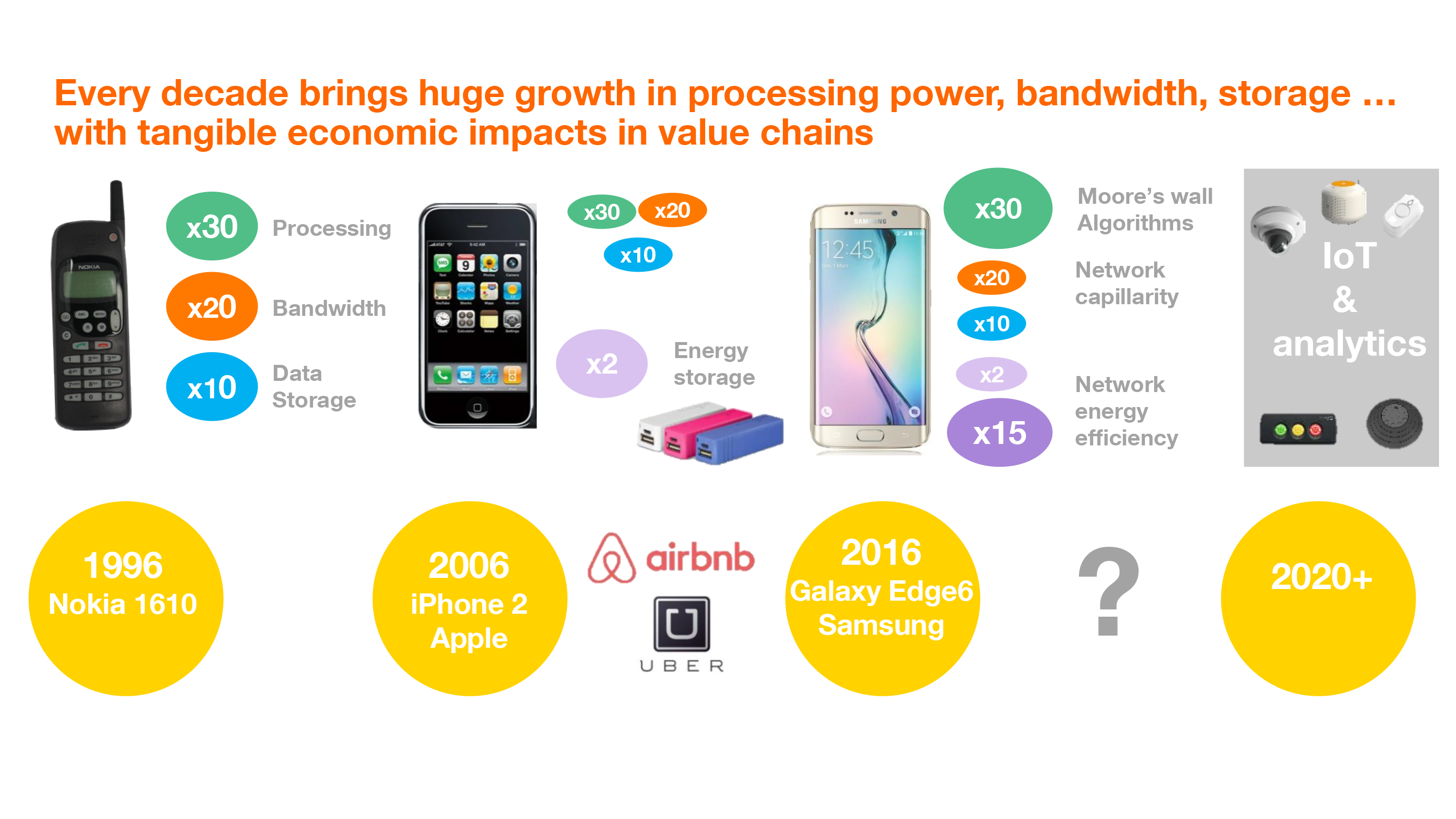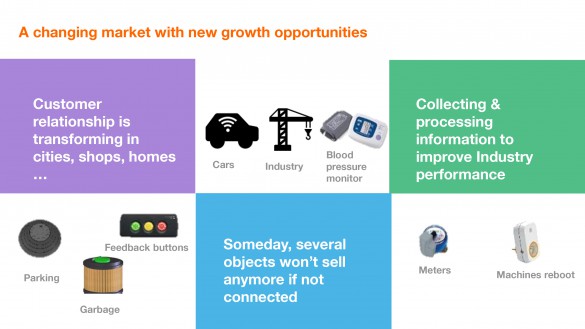It’s Orange’s ambition to hit Internet of Things (IoT) revenues in 2018 of €600 million. Orange Business Services is expanding its deployment of services ranging from construction machinery monitoring, to connecting cars, smart meter roll-outs, and industrial machine reboots.
As IoT Now‘s Jeremy Cowan reports in the first of a 2-part interview, the message from Orange Business Services is clear; ‘we’re not new in IoT, we’ve been doing this for years. The challenge now is to grow the IoT market.’
Olivier Ondet: I’m running the IoT Analytics Strategy Programme for Orange and I am the Marketing vice president for the IoT division within Orange Business Services, what we call Orange Application for Business, an area where we personalise a lot of IoT.
Networks are going to improve, going from 4G to 5G. But one thing that will be a big challenge of the next five to ten years is energy efficiency. Demands of energy use expended to send one bit of information, the battery power is going to keep increasing, especially because the smartphone industry and the car industry are intensively working on vehicles and energy storage.
But one thing that is improving a lot, from the network standpoint, is the energy efficiency brought by any LPWA (low power wide area) network, Today, the technology is available to deliver such networks, LoRa or Sigfox. With such networks you are about 16 times more efficient, so take the example of a meter sending one SMS per day to say how much water was consumed in area. If you take a big batch and send one SMS today using 3G or GSM it’s going to cost €200, and last for three years. For the same objects connected with LPWA technology it’s going to cost €50 and it will last for 13-15 years. So, in terms of the total cost of operation, obviously we are hitting areas where it’s much more efficient.
Some of the objects that you see we have put in place in projects we’ve already delivered, and which we are using as the ground for our IoT strategy. Just to comment on some of them; a video camera in buses where just by pressing the alarm button the driver can send images by 4G to the police system. There are already video cameras in buses but usually the videos work offline and we can work online. Then the police can understand if there are two drunk people or people with guns, and obviously their reaction will not be the same.
There is a home gateway, a ZigBee 3G gateway, meaning it’s connecting several devices in the home, like leak detectors, smoke detectors, door opening detectors, fall detectors, thinking of the risks to elderly people. When you fall it gives the information to the hub and then this hub is backed up with 3G, so it can work pretty much anywhere.
The other one is a leak detector, on the bottom part you’ve got a feedback button, green, yellow and red, which we installed on a motorway stop project. It’s a good way to know whether the toilets are clean or not. Another one is a parking sensor.
So many analysts are talking about billions of objects by 2020. It’s good to step back and see where these objects are, in what vertical. These figures are from Gartner, from their 2015 study where they rated that there would be 21 billion objects in the world by 2020. The figures there are the total number of objects per vertical and the growth rate between 2015 and 2020.
What’s interesting is where it’s going to hit billions and have a significant impact on lives or businesses, and where are the big peaks of growth of companies in IoT.
IT is bringing a lot of potential to the health business. There is automotive too, with sensors inside and outside cars for the tyres, and speeds; many objects can be better monitored with IoT. In industry the number of objects is about three billion, it’s about the same as what there will be in automotive but the growth rate is smaller because in industry there are already a lot of sensors but they are not really connected. A lot of them are doing stuff offline and they are collecting a lot of data.
So in industry it’s not only about knowing whether a parking space is free or not, that’s a very small amount of information to collect. It’s really extracting the right information out of the whole data to know what to do in terms of the predicted maintenance and managing workload and so on.
Last but not least, we are verticalising our go-to-market to hit the real use cases because part of the challenge in the next four to five years is to get the market to expand. It’s sorting between all the brilliant ideas that everybody has and making sure that the ones that really have market potential get through. That is the challenge.
Basically, we see three reasons why people are getting into IoT. One is about transforming customer relationships, in cities, in shops and homes. A few examples there are the parking sensor, the feedback button, and the garbage collector to know what the level of garbage collection is.
These three objects, plus a couple of others, we deployed on a motorway station South of Paris. They are all LoRa-connected objects by LPWA, and in this case there are 10 different kinds of sensors, including the feedback button, garbage collection, parking, liquid soap filling, to know whether there is still toilet paper. By collecting all this information the customers, the motorway operators, can better understand how the motorway station is running through different times of the summer, because it was installed at the end of June.
Improving customers’ relationships in homes and smart cities is definitely a key area. (There are) objects that someday won’t sell any more if they are not connected. You can start with the crane, we have a customer called Manitowoc, they are building and renting cranes out. We installed for them their connected cranes and we are getting information with 20 parameters, wind speed, daily and hourly load, if the engine’s working or not, the run rate and so on. It’s a way for them to improve their renting model because they know how the crane is used and if they are only renting per day they have a pay-per-use system. You can know whether the object has been stolen or not, which is an issue in construction.
For such big objects it’s already been happening for quite a time, to put in GPS connected with cellular. But with smaller objects that’s an area where we are seeing other projects with LPWA. With LoRa, especially in a remote area, you cannot put people with guns and dogs monitoring everything but if each object is localised and only triggers a single when moved, if it’s moved at 11.00 am it’s fair enough but if it’s moved at 2:00am you can trigger an alarm.
IoT Now: How long have Manitowoc been a customer?
OO: A couple of years now. They deploy something like 1,000 connected cranes in 27 countries.
IoT Now: Are there limitations on which countries or regions you’re able to operate in?
OO: It depends on the network technology. If it’s cellular it works pretty much everywhere. When it’s LPWA then today it’s much more limited because these low power networks are not available with 4G yet, so they are only available where we have deployed LoRa networks, which is France and specific hotspots like factories or motorway stations. Cellular is worldwide, and then it depends on the other technologies.
Today we are connecting two million cars out of the ten million connected objects that we manage on behalf of customers. We also manage the localisation and other information inside cars, for 110,000 of them. We do fleet management for companies that have pools of trucks or cars. We are also starting with rental companies because technology is shifting towards mass market cars.
Emergency call (eCall)
Mass market cars today are mostly connected with eCall, in case of emergency, triggering a call to the emergency service. Now the positioning solutions and remote maintenance are bringing in about 80 parameters to car manufacturers. This is starting to happen and so we are basically providing to the car industry the solutions to collect and process data wherever and whenever necessary. With a connected car they can provide a better service to their customers.
With connected cars there is also the change of bringing high bandwidth connectivity like Wi-Fi hotspots in cars, buses, trains and so on, we are also working on that. In that case the best technology to do that is 4G for the backhaul and you put a Wi-Fi 4G hub in the car.
With blood pressure monitoring that device is connected with Bluetooth. The information is automatically brought to the IT system so that it doesn’t have to be reconfigured, making it more reliable and secure because this is health information — we have certification for hosting health information in a secure way.
Lastly, we have use cases about meters and machine reboots. Today with one of our customers, Veolia, we installed almost two million water metres using LPWA technology, this was before LoRa was standardised, which was significant. We are also using the plug (see bottom right of the slide), an object that can be remotely monitored to shut down or turn on the power. As Orange Business Service, we provide a VPN (virtual private network) we have equipment that we put on customers’ premises with fixed connectivity and we can monitor them. In some cases what we have to do with routers is just switch them on and off, and it can be done remotely with these devices. Instead of sending someone, which can cost time and money, it can be done remotely with a secure SMS, secured with a SIM card on the GSM network. So those operations can be better performed.
IoT analytics
We are in IoT analytics, today we manage 10 million connected objects on behalf of our B2B customers. This started with M2M, meaning objects that our customers put in the hands of their own customers.
In insurance we are selecting the devices to be put in homes to provide better insurance systems to their own customers. We are supporting them in their IoT strategy. These 10 million connected objects, they are in all the verticals I mentioned including two million meters.
We also have 13 million tags, RFID tags mostly used in retail and industry, for tracking events. We don’t count them as IoT objects because they are not active. But still, when we see projects sometimes what our B2B customers want is just to detect a very small interaction, and the cost of the tags is just a few tens of cents so it can be much more efficient to do that and put the RFID sensors in the shops, in the retail case, in a booth where you can try the clothing.
In retail you can provide the consumer with advice about what kinds of clothes go better with other clothes, and you can also monitor and measure whether the pretty red skirt was sold immediately or was tried on once, twice or never before being sold. So this is also bringing some real-time information for the marketing and sourcing guys. In industry it’s about tracking the pallets ranging from shampoo bottles to beer.
All of these, whether active objects or passive, are collecting information and data that we operationalise for our customers. In the Orange Group today we have more than 700 IoT analytics experts.
The last figure which I can comment on is 65 million data per minute, so 1 million data every second, is what we manage for mostly two use cases. One is mobility events, so mobile networks in France, Belgium and Monaco. We detect mobility events, the mobile network always knows where your cell phone is. It keeps exchanging signal information with the network.
We are analysing all these events. Out of that we are extracting information for the tourism industry, for retail and for the transportation to tell them, statistically in an anonymised way, how many people are where, whether they are tourists or residents or excursionists and leaving before the end of the day, so not sleeping there, those particular indicators are interesting for the tourist industry. Whether they are going from Paris to Bordeaux by train, plane or car, because the behaviour on the mobile network is not the same. When they are going to a convention centre or retail mall whether there are more males or females between 20 and 30 or 30 and 40, and whether that’s different at 8:00am, 10:00am and 12:00pm.
So, this is the kind of information that we produce, harvesting the mobility information that circulates in our networks, applying the anonymisation and data mobility management protocols, that we can see for ourselves from the Orange side. We are applying big data to ourselves in a safe way because all of that has been validated by the French and Belgian privacy regulators.
We also have a similar case with security events on our network. We are carrying a lot of information and extracting and analysing 50 million data per minute to analyse potential security problems before they hit the companies. As part of our security portfolio we are selling many security services, but one of them is to help companies react if there is an attack, but also anticipate potential attacks. We see them start blossoming on our networks so we extract information from our networks to detect attacks before the companies are effected.
IoT Now: These are cyber-attacks within France and Belgium?
OO: No, worldwide. The 50 million data per minute is worldwide, the 50 million data per minute on mobility is France, Belgium and Monaco. We are expanding the geography but basically the source of the security event is our global network, as the Orange Group. The source for the mobility events is the local operations, as a B2C operator, where we have deployed the technology, which is currently for France, Belgium and Monaco. As Orange Business Services we are present in more than 160 countries. As a B2C operator with our own networks, we are present in 29 countries. But the technology can also be plugged into other mobile networks.
Orange Business Service, the B2B division of the Orange Group, has about 20,000 employees and a €7 billion turnover. The Orange Group in turn has a €40 billion turnover and 160,000 employees. Its ambition for the total Orange Group for B2C and B2B (business-to-business / consumer) is €600 million revenues in 2018 on IoT analytics.
Tomorrow Olivier Ondet describes the services that customers really want.
Comment on this article below or via Twitter: @IoTNow_ OR @jcIoTnow













